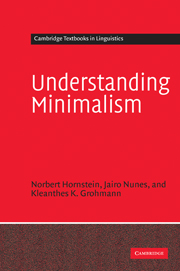Book contents
- Frontmatter
- Contents
- Preface
- List of abbreviations
- 1 The minimalist project
- 2 Some architectural issues in a minimalist setting
- 3 Theta domains
- 4 Case domains
- 5 Movement and minimality effects
- 6 Phrase structure
- 7 Linearization
- 8 Binding Theory
- 9 Feature interpretability and feature checking
- 10 Derivational economy
- Glossary of minimalist definitions
- References
- Language index
- Name index
- Subject index
1 - The minimalist project
Published online by Cambridge University Press: 05 June 2012
- Frontmatter
- Contents
- Preface
- List of abbreviations
- 1 The minimalist project
- 2 Some architectural issues in a minimalist setting
- 3 Theta domains
- 4 Case domains
- 5 Movement and minimality effects
- 6 Phrase structure
- 7 Linearization
- 8 Binding Theory
- 9 Feature interpretability and feature checking
- 10 Derivational economy
- Glossary of minimalist definitions
- References
- Language index
- Name index
- Subject index
Summary
The point of this book
This book is an introduction to the art of minimalist analysis. What we mean by this is that it aspires to help those with an interest in minimalism to be able to “do” it. Partly this involves becoming acquainted with the technology that is part and parcel of any specialized approach. Partly it involves absorbing the background assumptions that drive various aspects of the enterprise. However, in contrast to many earlier approaches to grammar, we believe that “doing minimalism” also involves developing an evaluative/aesthetic sense of what constitutes an interesting problem or analysis and this is not a skill that one typically expects a text to impart. So, before we begin with the nuts and bolts of the Minimalist Program, we'll spend some time outlining what we take the minimalist project to be and why its ambitions have come to prominence at this time.
But before we do that, let us briefly address who this book is for. It aims to introduce the reader to the minimalist approach to the theory of grammar. It doesn't start at zero, however. Rather, it presupposes an acquaintance with the large intellectual concerns that animate generative linguistics in general and some detailed knowledge of generative syntax in particular. Our optimal reader has a good background in the Principles-and-Parameters (P&P) approach to grammar, in particular the model generally referred to as Government-and-Binding (GB) theory.
- Type
- Chapter
- Information
- Understanding Minimalism , pp. 1 - 18Publisher: Cambridge University PressPrint publication year: 2005



